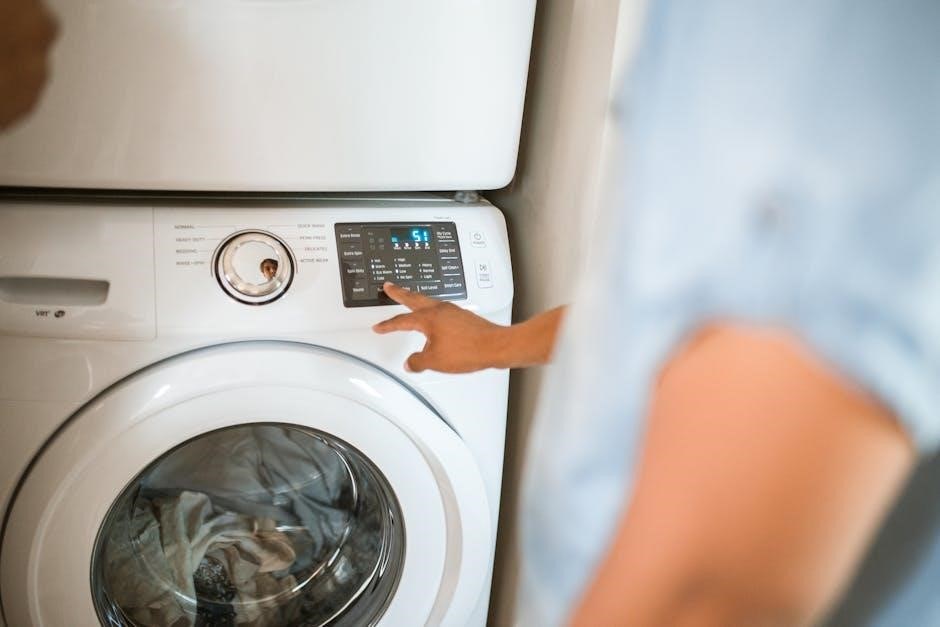Welcome to your guide on Hotpoint washing machine drawer instructions! This section is designed to introduce you to the basics of your machine’s detergent drawer, its purpose, and why understanding its function is essential for optimal washing performance.
The detergent drawer of your Hotpoint washing machine is a crucial component, responsible for dispensing detergents, fabric softeners, and other laundry additives at the appropriate times during a wash cycle. Understanding its function is essential for achieving clean, fresh-smelling laundry and maintaining the longevity of your appliance.
This guide will walk you through everything you need to know about your Hotpoint washing machine drawer, from identifying your specific model to troubleshooting common issues. We’ll cover how to properly use each compartment, remove the drawer for cleaning, tackle stubborn build-up, and ensure the drawer housing remains free from blockages.
Regular maintenance and proper usage of the detergent drawer can prevent problems such as detergent residue build-up, mold growth, and dispensing issues. By following the steps outlined in this guide, you’ll be able to keep your Hotpoint washing machine running smoothly and efficiently, ensuring optimal cleaning performance with every load.
Whether you’re a new Hotpoint washing machine owner or simply looking to improve your laundry routine, this guide provides the information you need to master your machine’s detergent drawer and achieve consistently excellent results.
Identifying Your Hotpoint Washing Machine Model
Before diving into specific instructions for your Hotpoint washing machine drawer, it’s crucial to identify your exact model. Different Hotpoint models may have slight variations in drawer design and functionality. Knowing your model number ensures you’re following the correct instructions for your specific appliance.
The model number is typically located on a sticker or plate on the washing machine. Common locations include the inside of the door, the back panel, or behind the detergent drawer itself. Look for a series of numbers and letters, such as “WMA36” or “BHWM 129”;
Once you’ve located the model number, you can use it to find your machine’s user manual online. The Hotpoint website and other appliance resources offer digital manuals that provide detailed information about your specific model, including diagrams of the detergent drawer and instructions for its removal and cleaning.
Having the correct model number will also be helpful when ordering replacement parts, such as a new detergent drawer if needed. Accurate identification ensures you receive the right part for your machine, preventing compatibility issues and ensuring a proper fit.
Take a moment to find and record your Hotpoint washing machine model number; This simple step will save you time and frustration as you navigate the instructions in this guide and maintain your appliance.

Understanding the Detergent Drawer Compartments
Your Hotpoint washing machine’s detergent drawer is designed with specific compartments for different types of laundry products. Understanding these compartments is essential for proper detergent dispensing and optimal wash results. Typically, you’ll find three main compartments, each marked with a symbol or number.
The first compartment, often marked with “I” or a single bar, is for pre-wash detergent. This is used when you want to pre-soak heavily soiled items before the main wash cycle. The second compartment, marked with “II” or two bars, is for the main wash detergent. This is where you’ll add your regular laundry detergent, whether it’s powder or liquid.

The third compartment, usually marked with a flower or a star, is for fabric softener. Adding fabric softener to this compartment ensures it’s dispensed during the final rinse cycle, leaving your clothes soft and fresh. Some models may also have a compartment for bleach, indicated by a triangle symbol.
It’s crucial to use the correct compartments for each product. Adding detergent to the fabric softener compartment, or vice versa, can lead to improper dispensing and ineffective washing. Refer to your washing machine’s user manual for specific instructions on which products to use in each compartment and the recommended dosage.
By understanding the purpose of each compartment, you can ensure your laundry products are dispensed correctly, leading to cleaner, fresher clothes and a longer lifespan for your washing machine.
How to Remove the Detergent Drawer
Removing the detergent drawer from your Hotpoint washing machine is a simple process that allows for thorough cleaning and maintenance. Before you start, make sure the washing machine is turned off and unplugged from the power outlet for safety.
To remove the drawer, first, gently pull it out as far as it will go. You’ll likely encounter some resistance. Look for a release mechanism, which is usually a button or lever located in the center of the drawer or at the top, near where it meets the machine. Press or lift this release mechanism while simultaneously pulling the drawer firmly but gently. The drawer should slide out completely.
If you’re having trouble finding the release mechanism, consult your washing machine’s user manual. It will provide specific instructions and diagrams for your model. Avoid forcing the drawer, as this could damage the release mechanism or the drawer itself.
Once the drawer is removed, take a moment to inspect the empty cavity inside the washing machine. This is a good opportunity to check for any blockages or buildup that may be affecting the detergent dispensing process.
With the drawer removed, you can now proceed with cleaning it thoroughly. Removing the drawer regularly not only helps maintain the cleanliness of your machine but also ensures optimal performance and prevents the buildup of mold and detergent residue.
Cleaning the Detergent Drawer: A Step-by-Step Guide
Once you’ve removed the detergent drawer from your Hotpoint washing machine, the next step is to clean it thoroughly. This process removes detergent residue, mold, and bacteria, ensuring optimal performance and hygiene.
First, rinse the drawer under warm, running water. This will help to loosen any loose detergent buildup. Next, prepare a solution of warm, soapy water. You can use dish soap or a mild detergent.
Using a brush, such as an old toothbrush or a specialized dispenser cleaning brush, scrub all the compartments of the drawer. Pay close attention to corners and edges where buildup tends to accumulate. For stubborn residue, let the drawer soak in the warm, soapy water for a few minutes before scrubbing.
After scrubbing, rinse the drawer thoroughly under running water to remove all traces of soap. Make sure no soap residue remains, as this can affect detergent dispensing in future washes.
Finally, dry the drawer completely with a clean towel before reinstalling it in the washing machine. Ensure that all compartments are dry to prevent mold growth. Regular cleaning, ideally once a month, will keep your detergent drawer in good condition and your washing machine running efficiently.
Dealing with Stubborn Build-Up and Mold
Sometimes, regular cleaning isn’t enough to tackle stubborn build-up and mold in your Hotpoint washing machine’s detergent drawer. Here are some methods for handling these tougher cleaning challenges.
For stubborn detergent residue, try soaking the drawer in a solution of hot water and white vinegar. The acidity of the vinegar helps to break down the buildup. Let it soak for at least 30 minutes, or even overnight for severe cases.
If mold is present, use a solution of bleach and water (always wear gloves and eye protection). Apply the solution to the affected areas and let it sit for about 15 minutes before scrubbing with a brush. Rinse thoroughly to remove all traces of bleach.
A paste of baking soda and water can also be effective for removing stubborn stains and odors. Apply the paste to the affected areas, let it dry, and then scrub and rinse.
For hard-to-reach areas, use cotton swabs or pipe cleaners to apply cleaning solutions and remove debris. Always ensure thorough rinsing after using any cleaning agent to prevent residue from affecting future washes.
Regularly inspect the drawer for signs of build-up or mold, and address them promptly to prevent them from becoming major problems.
Checking for Blockages in the Drawer Housing
After cleaning the detergent drawer itself, it’s crucial to check the drawer housing within the washing machine for any blockages. Residue and debris can accumulate in the housing, hindering proper water flow and detergent dispensing.
First, use a flashlight to inspect the housing for any visible obstructions. Common culprits include clumps of detergent, fabric softener residue, and small objects that may have fallen in.
To remove loose debris, you can use a damp cloth or a small brush. For more stubborn blockages, try using a long, flexible tool like a bottle brush or a pipe cleaner to dislodge the buildup.
Another effective method is to use a solution of hot water and vinegar. Pour the solution into the drawer housing and let it sit for about 30 minutes to help dissolve any residue. Then, flush the housing with clean water.
If you suspect a more significant blockage, you may need to remove the top panel of the washing machine to gain better access to the housing. However, this should only be done if you are comfortable working with appliances and have the necessary tools.
Regularly checking and cleaning the drawer housing will ensure that your Hotpoint washing machine dispenses detergent effectively.
Proper Detergent Usage and Placement
Using the correct type and amount of detergent, and placing it in the appropriate compartment, is crucial for achieving optimal washing results with your Hotpoint washing machine.
Firstly, consult your washing machine’s manual to determine the recommended type of detergent for your machine. Some machines are designed for use with high-efficiency (HE) detergents, while others are not.
Secondly, always measure the detergent carefully. Using too much detergent can lead to excessive suds, which can prevent the machine from rinsing clothes properly. Conversely, using too little detergent may not effectively clean your clothes.
Next, familiarize yourself with the different compartments in your detergent drawer. Typically, there are separate compartments for pre-wash detergent, main wash detergent, and fabric softener.
Place the detergent in the main wash compartment, usually marked with a “II” symbol. If you are using a pre-wash cycle, add detergent to the pre-wash compartment, marked with a “I” symbol.
Finally, pour fabric softener into the designated compartment, usually marked with a flower symbol. Avoid overfilling the compartment, as this can cause the fabric softener to dispense prematurely.
By following these guidelines, you can ensure that your Hotpoint washing machine dispenses detergent effectively.
Reinstalling the Detergent Drawer
After cleaning or inspecting your Hotpoint washing machine’s detergent drawer, properly reinstalling it is essential to ensure seamless operation. Before you begin, make sure the drawer and the drawer housing are completely dry.
Carefully align the drawer with the opening in the washing machine. Most Hotpoint models have guide rails or grooves on the sides of the drawer and the housing.
Gently slide the drawer back into the housing, ensuring that it moves smoothly and without resistance. If you encounter any difficulty, do not force it.
Check for any obstructions or misalignments. Once the drawer is properly aligned, it should slide in easily until it is fully seated.
On some models, you may need to lift the drawer slightly as you slide it in to clear any internal mechanisms.
Once the drawer is fully inserted, test it by opening and closing it a few times to ensure it moves freely and securely.
If the drawer feels loose or wobbly, double-check that it is properly aligned and fully seated.
A properly reinstalled detergent drawer will ensure that detergent and additives are dispensed correctly during each wash cycle.

Troubleshooting Common Drawer Problems
Even with regular maintenance, you might encounter issues with your Hotpoint washing machine detergent drawer. One common problem is the drawer being difficult to open or close. This is often due to detergent build-up or obstructions.
Ensure you’ve thoroughly cleaned the drawer and its housing, removing any residue. If the drawer is leaking, it could be due to excessive detergent use or a blockage preventing proper drainage.
Verify that you’re using the correct amount of detergent and that the drawer compartments are not overfilled.
Another issue is the detergent not dispensing correctly. This can result from clogged dispenser nozzles or low water pressure;

Check the nozzles for any blockages and ensure your water pressure meets the machine’s requirements.
Sometimes, the drawer may not stay closed properly, which can be caused by a broken or worn-out latch mechanism.
Inspect the latch for damage and consider replacing it if necessary. If you experience persistent problems, consult your Hotpoint washing machine’s manual or contact a qualified appliance repair technician for assistance.
Preventative Maintenance for a Clean Drawer
To keep your Hotpoint washing machine detergent drawer in top condition and avoid common problems, preventative maintenance is key. Establish a regular cleaning schedule, aiming to clean the drawer at least once a month. This will prevent the build-up of detergent residue, mold, and bacteria.
After each wash cycle, leave the drawer slightly ajar to allow air circulation. This helps to dry out any remaining moisture and prevents mold growth.
Use the correct amount of detergent as specified in your washing machine’s manual and the detergent packaging. Overusing detergent can lead to excessive build-up and blockages.
Periodically check the water inlet valve and hose for any sediment or debris that could affect water flow to the drawer.
Flush the drawer housing with hot water to remove any loose particles.
By following these preventative measures, you can ensure your Hotpoint washing machine detergent drawer remains clean, functional, and contributes to the efficient operation of your appliance.
